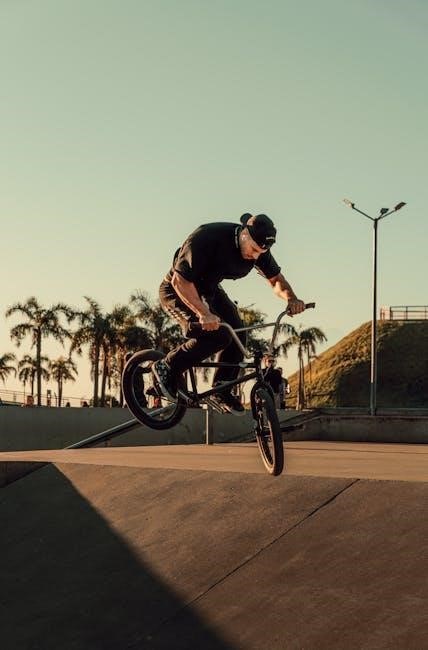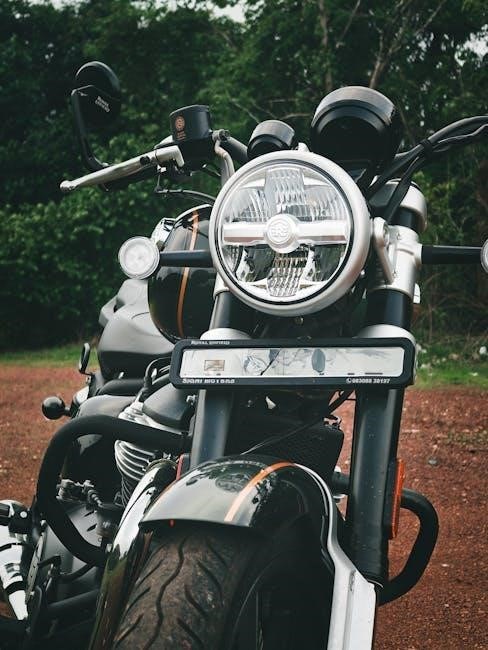A guide bike is a versatile cycling companion designed to enhance your riding experience. Whether for commuting, touring, or recreational purposes, it offers unmatched freedom and efficiency.
1.1 Definition and Purpose
A guide bike is designed to assist riders in navigating various terrains with ease and confidence. Its primary purpose is to provide stability, control, and versatility, catering to cyclists who seek a reliable companion for both on-road and off-road adventures. Whether for training, touring, or commuting, a guide bike ensures a balanced riding experience. It is particularly beneficial for those who need additional support or are transitioning to more challenging trails. By combining durability and adaptability, guide bikes empower riders to explore diverse landscapes while maintaining optimal performance. Choosing the right type of guide bike depends on your riding style, terrain preferences, and budget.
1.2 Importance of Choosing the Right Bike Type
Selecting the right bike type is crucial for ensuring a safe, enjoyable, and efficient riding experience. Different bikes are designed for specific purposes, such as road bikes for speed on paved surfaces or mountain bikes for rough terrains. Choosing a bike that aligns with your riding style and terrain ensures better performance, comfort, and control. A mismatched bike can lead to discomfort, reduced efficiency, or even safety risks. By understanding your needs and preferences, you can opt for a bike that enhances your cycling experience and provides long-term satisfaction. The right bike type also reduces the risk of injury and makes every ride more enjoyable and fulfilling.

Types of Bikes

Bikes are categorized into road, mountain, hybrid, city, and kids’ bikes, each tailored for specific terrains and riding styles to ensure optimal performance and comfort for cyclists.
2.1 Road Bikes
Road bikes are designed for speed and efficiency on paved surfaces, making them ideal for racing, training, and long-distance rides. Their lightweight frames, narrow tires, and aerodynamic designs reduce air resistance, allowing cyclists to maintain high speeds with less effort. These bikes typically feature drop handlebars, enabling riders to adopt a streamlined position for better performance. Road bikes are further categorized into subtypes like Aero, Ultralight, and Endurance bikes, each catering to specific riding preferences. Whether for competitive racing or recreational touring, road bikes offer unparalleled speed and precision on asphalt roads, making them a favorite among cyclists seeking thrilling on-road experiences.
2.2 Mountain Bikes
Mountain bikes are sturdy, versatile bicycles built to conquer rough terrain, including rocky trails, steep hills, and unpaved paths. Equipped with wide, knobby tires for maximum grip and flat handlebars for better control, these bikes are designed to handle challenging off-road conditions. Their robust frames, often made of steel, carbon fiber, or aluminum, ensure durability and stability. Mountain bikes feature powerful disc brakes for reliable stopping power and low gears for easier climbing. Whether for casual trail rides or competitive racing, mountain bikes offer unparalleled adaptability and performance in off-road environments, making them a favorite among adventurers seeking thrilling experiences in nature.
2.3 Hybrid Bikes
Hybrid bikes combine the best features of road and mountain bikes, offering versatility for various riding conditions; Designed for comfort and practicality, they feature upright handlebars, padded seats, and lightweight frames. Their tires are wider than road bikes but narrower than mountain bikes, providing a smooth ride on both paved roads and light trails. Ideal for commuting, casual rides, and fitness, hybrid bikes are a great choice for those seeking a balanced cycling experience. They often include mounts for racks and fenders, making them suitable for everyday use. Their adaptability and comfort make hybrid bikes a popular option for riders who want a versatile bicycle.

Choosing the Right Bike
Selecting the right bike involves balancing functionality, comfort, and personal preference. Consider your riding habits, terrain, and goals to find a bike that suits your needs perfectly.
3.1 Terrain and Riding Style
Your choice of bike heavily depends on the terrain you ride on and your personal riding style. For smooth, paved roads, road bikes are ideal due to their aerodynamic design and lightweight frames, allowing for speed and efficiency. Mountain bikes, with their sturdy frames and wide, knobby tires, are perfect for rough, off-road trails, offering stability and control. Hybrid bikes strike a balance, suitable for both urban commuting and light off-road adventures. Consider whether you prioritize speed, comfort, or handling, as different bike types cater to these preferences. Matching your bike to your terrain and style ensures a more enjoyable and effective riding experience.

3.2 Budget and Features
Your budget and desired features are crucial when selecting a bike. Road bikes can range from affordable entry-level models to high-end carbon fiber designs, while mountain bikes vary based on suspension quality and durability. Hybrid bikes often offer great value for everyday commuting. E-bikes, with their advanced motors and batteries, are pricier but provide unparalleled convenience. Setting a budget helps narrow your options, ensuring you balance cost with the features that matter most to your riding style. Consider whether you need extras like cargo racks, lighting, or advanced gearing systems. Prioritizing your needs and budget ensures you find the perfect bike for your preferences and terrain.
3.3 Size and Comfort

Size and comfort are essential for an enjoyable riding experience. A bike that fits your body ensures proper ergonomics and reduces fatigue. Start by considering your height and inseam to determine the ideal frame size. Saddle height should allow a slight bend in your knee when the pedal is at its lowest point. Handlebar height and reach should align with your riding style—upright for comfort or lower for efficiency. Test ride bikes to assess comfort, paying attention to seat design, grip feel, and overall posture. Don’t hesitate to adjust components like stems or saddles to optimize your fit. Comfort equals confidence on the road or trail;

Specialized Bikes
Specialized bikes cater to specific riding needs, offering unique features for optimal performance. Track bikes prioritize speed, e-bikes provide motorized convenience, and touring bikes are built for long-distance adventures.
4.1 Track Bikes
Track bikes are specialized bicycles designed for racing on closed circuits or velodromes. Built for speed, they feature lightweight frames, fixed-gear drivetrains, and aerodynamic designs. These bikes eliminate unnecessary components like brakes to minimize weight and maximize efficiency. Riders typically adopt a streamlined position to reduce air resistance. Track bikes are ideal for competitive racers seeking peak performance, offering a pure, unadulterated cycling experience. Their simplicity and focus on speed make them a favorite among professionals and enthusiasts alike. Whether sprinting or enduring long laps, track bikes deliver unparalleled acceleration and control in controlled environments.
4.2 E-Bikes
E-bikes, or electric bicycles, are versatile bikes equipped with electric motors and batteries to assist pedaling. They offer enhanced speed and ease, especially on long rides or steep terrains. E-bikes come in various types, including throttle-controlled and pedal-assist models. Throttle e-bikes allow riders to accelerate without pedaling, while pedal-assist models provide power only when pedaling. These bikes are ideal for commuting, touring, or recreational rides, offering a convenient and efficient alternative to traditional bicycles. Modern e-bikes often feature advanced technologies like adjustable power modes and long-range batteries. Their versatility and ease of use make them a popular choice for cyclists of all skill levels and purposes.
4.3 Touring Bikes
Touring bikes are specifically designed for long-distance travel, combining durability, comfort, and practicality. These bikes feature sturdy frames, wide tires, and mounts for panniers and racks, allowing riders to carry gear for extended adventures. Equipped with comfortable seating and multiple gear options, touring bikes are ideal for both on-road and light off-road excursions. They cater to cyclists seeking a balance between performance and versatility, making them perfect for multi-day trips or global exploration. Touring bikes emphasize endurance and reliability, ensuring riders can traverse various terrains with ease and confidence, while also providing the freedom to enjoy scenic routes and immersive experiences along the way.
Selecting the right bike involves balancing purpose, terrain, and personal preferences, ensuring a seamless riding experience tailored to your unique needs and adventures.
5.1 Final Tips for Selecting Your Guide Bike
- Define your purpose: Determine whether you’ll be riding on roads, trails, or commuting in the city to narrow down your options.
- Test ride: Always take a bike for a spin to ensure it feels comfortable and handles well under your preferred conditions.
- Consider features: Think about gears, brakes, and accessories like racks or fenders based on your needs.
- Size matters: Ensure the bike fits your body to avoid discomfort and maintain control during rides.
- Stay within budget: Set a price range and balance features with affordability to find the best value for your money.


